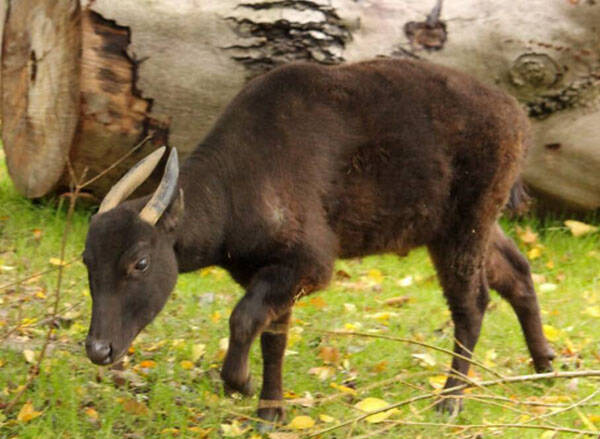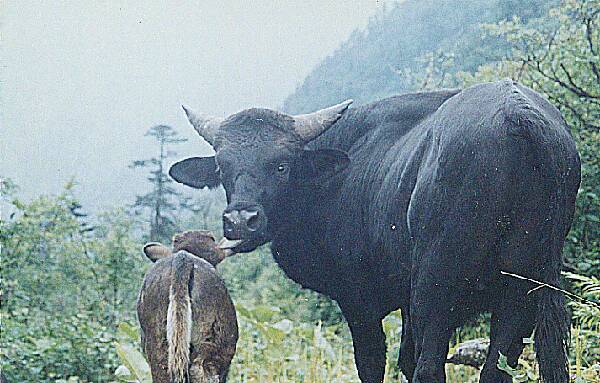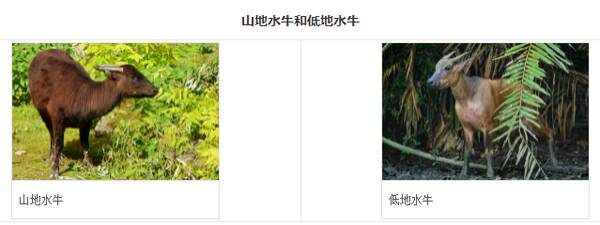Bubalus quarlesi
IUCN
LCBasic Information
Scientific classification
- name:Bubalus quarlesi
- Scientific Name:Bubalus quarlesi,Mountain buffalo, Buffalo quagga
- Outline:Ungulata
- Family:Artiodactyla Bovidae Buffalo
Vital signs
- length:About 150 cm
- Weight:150-300kg
- lifetime:20-25years
Feature
It is the smallest species of buffalo.
Distribution and Habitat
Sulawesi, Indonesia. This species is endemic to Indonesia and is only found on the southeastern coastal islands of Sulawesi and Buton, with no records from other small islands adjacent to Sulawesi. The typical altitude records for the species range from 1,000-2,300 m, but it can be found near sea level. It is uncertain whether the two putative species, mountain buffalo and lowland buffalo, are companions or hybrids in distribution. The local distribution of mountain buffalo remains unclear throughout Sulawesi, as they may occur in forest patches at different altitudes or companions.
It mainly inhabits rainforests, usually in hilly areas. Although usually found at altitudes of 1,000-2,300 m above sea level, altitude does not distinguish this species from lowland buffalo, as in some areas mountain buffalo inhabit forests near sea level. Dense forests seem to be preferred, especially those with relatively low density of tall trees and high diversity of understory vegetation. It is freq
Appearance
The smallest species of buffalo, the mountain buffalo looks like a deer but is actually a buffalo. They weigh between 150-300 kg. Both male and female mountain buffaloes have horns, which are conical and curved backwards. The horns are 15-20 cm long and have a smooth surface without ridges. The front of these horns is flat but becomes triangular from the middle to the tip. Their fur color is dark brown or black but changes between 2-4 months after molting. After molting, the animal loses its shaggy fur and baldness appears on the head, neck, and limbs. The head develops white spots on each side of the cheeks, while crescent-shaped baldness appears on the front side of the neck. Light spots also appear above the hooves. The fur on the neck becomes shorter, while the long hair on the body remains. The senses are sharp and the sense of smell is well developed, which plays an important role in the domestication process. The skin is thick and the coat is short and sparse. Sweat glands are n
Details
Mountain buffalo (scientific name: Bubalus quarlesi) is called Mountain Anoa in English, Anoa de quarle, Anoa des montagnes in French, Anoa de Montaña in Spanish, Berg-Anoa, Berganoa in German, and has no subspecies. It is the smallest species in the genus Buffalo of the order Artiodactyla, family Bovidae, and order Buffalo, also known as Dwarf Buffalo.

Mountain buffaloes live in quiet mountain forests at high altitudes. Except for the breeding season, mountain buffaloes prefer to live alone or in pairs rather than in groups. But they will move in groups during the breeding season. The most active time is morning and evening. They like water and like to roll in mud to dissipate heat and prevent insect bites. Feeding occurs in the morning and evening, with the rest of the time spent resting and ruminating. Because the species is diurnal, these animals have well-developed vision. They communicate with visual signals in some way. Tactile communication may be important, especially between pairs and between a mother and her young. Information about the identity of an individual is transmitted by scent. These animals may also make some vocalizations, although this has not been reported.
Adult male mountain buffaloes exhibit some behaviors that may reinforce territorial ownership or dominance within the group. These behaviors include ramming bushes and branches with their horns, digging in the soil with their horns, and scraping the ground with their front feet (usually after scenting the area, and half the time urinating on the scraped soil). Hierarchical relationships between individuals are reinforced by dominant individuals pushing the forehead or knocking the horns of less dominant animals on the side or rump, resting their chin or cheek on their rump, or resting one (rarely two) front legs on their body. When approached by a dominant animal or in response to contact, the submissive animal will adopt a posture with the head lowered and tilted forward and the horns held close to the neck. More extreme submissive behavior involves the less dominant animal lying down with the neck and chin pressed to the ground.
Mountain buffalo indirect aggressive encounters often involve postures and ritualized displays, with one animal lowering its head with its mouth close to the ground and its forehead almost vertical. If the other animal resumes this posture, the two antelopes will face each other, but rarely approach. This "standoff" behavior was seen in 18% of aggressive encounters and is likely to be a threat, usually a point, but avoids actual combat. In more aggressive situations, the head is bent further, with the forehead close to the ground and the horns pointed at the opponent. Aggressive charges are directed at the opponent with the head in a normal position or with the ears pointed back and raised. This is accompanied by a brief, soft grunt or a huff. If the opponent does not flee, the charge ends. Next, the opponent may be struck with a forehead thrust to the shoulder or side, or with the horns in an upward stroke to the abdomen or side. Aggression initiated by adult males is primarily directed at young bulls, while adult females primarily display the same behavior toward adult males.

Mountain buffalo are herbivorous animals that feed on plants from forests and open areas, including those produced by avalanches and characterized by secondary plant succession. The 27 plant species eaten in Lore Lindu National Park in Central Sulawesi included seven grasses and grass-like species: carpet grass, bamboo grass, hair grass, two-ear grass, carex, green sedge and yellow sedge. Three ferns: Repplaumium repandum, Neprolepis radicans and Sphaerostephanos unitus. Tree species: Castanopsis acuminatissima, Elaeocarpus moribundus and Calophyllum soulattri and several weeds: Calamus sp., Homalomena sp., Elaphantopus scaber, Ageratum, Blumea balsamina, Desmodium scorpluusus, Rusvia hispanica, Elastostema lineolatum, Tetrastigma pedunculare, Deparia patersonii and Strobilifera. The diet of mountain buffaloes consists of 38% woody plants, 9% ferns, 16% broad-leaved plants, 17% grasses and sedges, 5% other monocots and 13% mosses. Mountain buffalo are reported to visit mineral-rich hot springs and salt licks in the wild, and there are also reports that they may drink seawater, which may meet mineral needs in areas where licks or mountain springs are not available.
During the breeding season, males test the fertility of females by exposing the scent of fresh urine to the vomeronasal organ using the "slit-lip sniffing behavior" (flehmen). This action is usually maintained for 7 seconds. (Males occasionally jump after licking the penis, and females may perform a variety of behaviors in response to olfactory stimulation). If the female is receptive, the male follows her head forward until it is at shoulder height and neck level. This position allows the male to lick the female's vulva to induce urination. The pursuit is intensified by punching the forehead and raising the neck to bring the muzzle into contact with the female's rump. After continuing to engage in sexual swimming and interspersed testing the female's urine, the male places his chin on the female's rump and then mounts. During mating, the male's head and neck are pressed against the female's back and shoulders, and his front legs are pressed against the female's flank. Both males and females make short mooing noises throughout the courtship process. Mountain buffalo do not have a defined breeding season, with a gestation period of 275-315 days, one calf per litter, and weaning at 6-9 months. Females give birth in herds. Calves are able to walk around with their mothers soon after birth. Like all mammals, females provide milk to their calves and protect their children. The species reaches sexual maturity after two years.
Mountain buffalo have smaller and less conspicuous markings than lowland buffalo. The slender legs are brown-black throughout their length, which is the main distinguishing feature from lowland buffalo, where the front legs are always lightly spotted from the knee. Small white spots may appear above the front hooves, but they are usually difficult to see. The groin area is lighter in color than the back, but not white. The tail of the mountain buffalo is actually and relatively shorter than that of the lowland buffalo, accounting for 14.6-17.8% of the total length.

The species is strictly protected by Indonesian law, with hunting strictly prohibited, key sites for prevention of habitat loss, complete genetic research to better define the taxonomy of this species, and to determine the status of the remaining population. A combination of law enforcement and education is used to reduce hunting pressure.
Estimating population size is further complicated by uncertainty in the distribution of both lowland and mountain wild buffalo species. Mountain buffalo are thought to number fewer than 2,500 mature individuals. The species has declined throughout Sulawesi, particularly in the south and northeastern peninsulas, with declines attributed to hunting for meat and habitat loss. Most populations are rapidly fragmenting, suggesting that conservation of viable populations may soon require subpopulation management. No subpopulation is thought to exceed 250 mature individuals. The status of the species is therefore of concern, as populations are reported to be declining even in large protected areas and other large forested plots due to heavy hunting pressure. The largest declines have been seen in two areas: Gorontalo and Buol Toli-Toli. Overall, the rate of decline is not known, however, based on distribution surveys and questionnaires, the species' range is retreating toward the middle of the forested area. It is believed that the population decline rate between two generations of species is 20% (7-9 years for one generation).
Listed in the IUCN Red List of Threatened Species in 2016 ver3.1 - Endangered (EN).
Listed in the CITES Appendix I of the Washington Convention as a protected animal.
Protect wild animals and eliminate game.
Maintaining ecological balance is everyone's responsibility!








